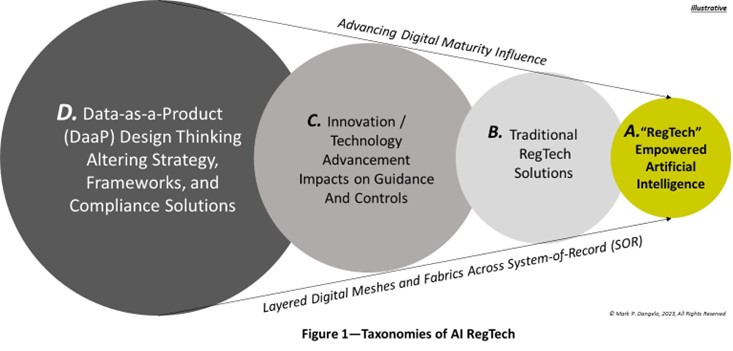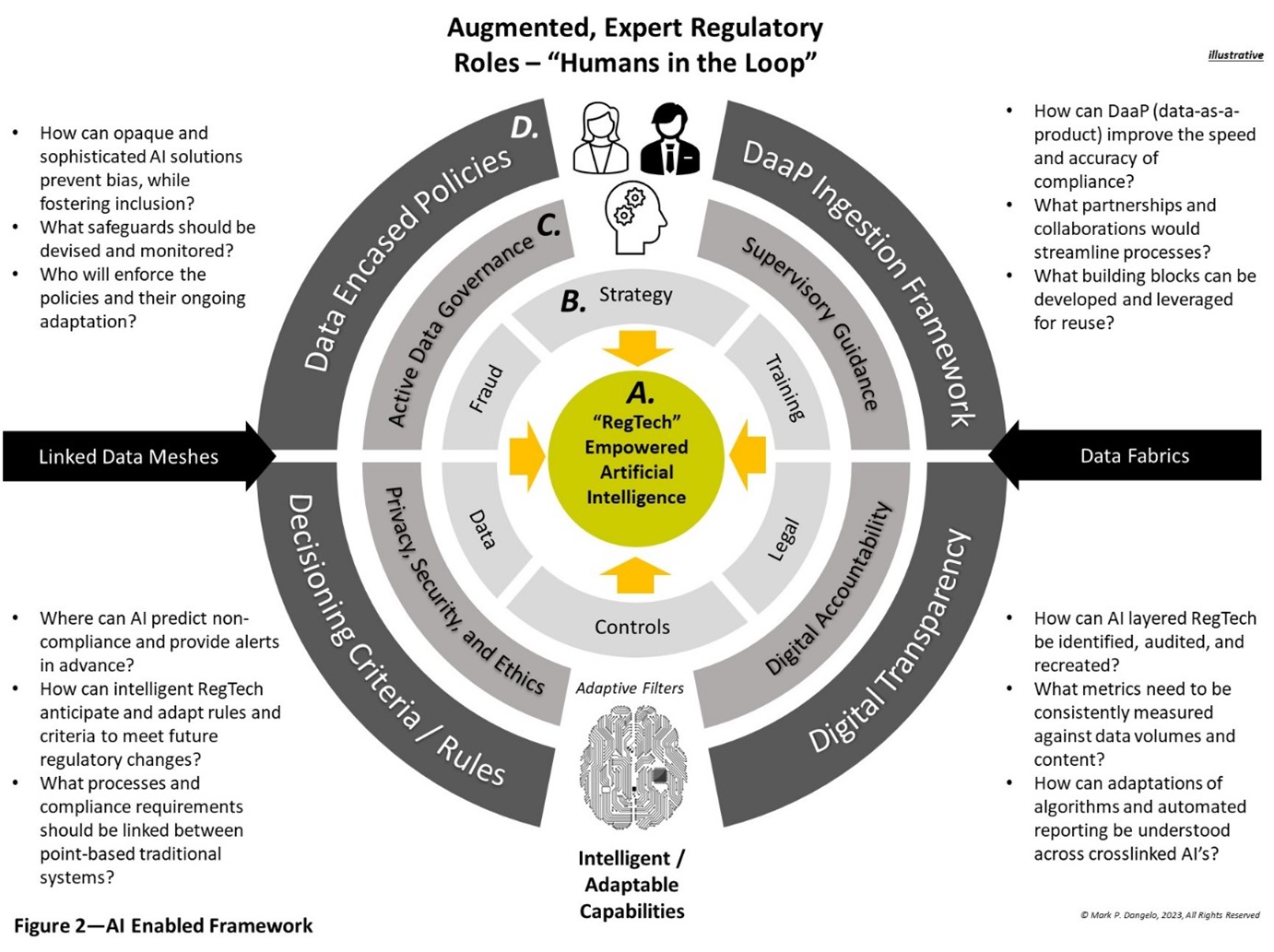The success of AI-enabled regtech implementation hinges on asking the right questions around whether industry leaders and regulators should utilize the same mindsets and business models of prior designs — specifically, determining if we are even asking the right design and solution questions for what a quantum phase shift is and how data and technology are utilized
In this two-part blog series, we look at the evolving state of artificial intelligence-enabled regulatory compliance and how they can be sustainably implemented
In the first part of this series, we identified the business and operating model changes that will be required to take advantage of the blending of regulatory technology (regtech), artificial intelligence (AI), and human skills. Further, we looked at how we could ask different questions to achieve sustainable results in implementing AI-enabled regtech by utilizing a non-traditional framework.
Now, we will explore an architectural strategy and framework for these design criteria as well as for deploying data building blocks capabilities. To provide a foundation for assessing and addressing the solution framework that blends regtech, AI, and humans in the loop, transformation leaders need to contrast future demands against traditional monolithic, siloed designs.
What is the solution strategy?
AI-enabled regtech does not represent an off-the-shelf or plug-and-play set of solutions that are common with nascent AI and traditional regtech. AI-enabled regtech demands an engineering approach, which adheres to a crawl-walk-run set of techniques and methods.
Figure 1 below presents a visualization of an engineering design progression showcasing the importance of advancing digital sciences within a potential regulatory set of progressive solutions. The goal for many who live within the regulatory community is to arrive at the segment labeled A with new controls and criteria to govern the use of AI within the traditional regtech solutions seen in the segment labeled B.

However, this tight coupling of solutions when integrated with the growing innovation capabilities and research sciences (shown in the segment labeled C), ignores the foundational demands of merely bolting on more information or technology capabilities, which is a common approach to a solution. Generally, most traditional ideas concentrate around C as the home of AI when it comes to its incorporation and ultimate value proposition for regulatory compliance. That, however, would be a mistake.
AI is at its foundation a data-driven, data-design solution that ingests vast amounts of digital data to feed its complex algorithms and outcomes. As this data changes and exponentially expands (as shown in the segment labeled D), so does the digital maturity needed to maintain innovative relevance and produce accurate results. It is the unaccounted rationale and implications of D that significantly contributes to the 80% to 90% failure rates surrounding AI implementations today.
Taken holistically, Figure 1 illustrates the solution focus is always on A and the traditional segments within B, but the future untapped value for AI-enabled regtech resides in C and D. Additionally, the advancements in data sciences — coupled with trends such as cloud computing — have provided the building blocks necessary for AI and for its robust, proactive integration into governance and oversight.
What is the framework of implementation?
As noted previously, the question becomes: Are industry professionals just adhering to the letter of the law, or can they embrace the spirit of the regulation, which in the end demands that alternative questions be asked. For example, just a few of the questions around framework design requirements that will be beneficial for regulatory compliance surrounding the implementation of AI-enabled regtech capabilities to be asking would include:
-
-
- Across emerging digital ecosystems and demographics, will prescriptive, rule-driven solutions still be the norm when it comes to AI — a technology that itself is adaptative and operationally transformative and digitally disruptive?
- What are the impacts when it comes to regtech, audits, or even tax strategies if current computing designs are replaced with data-driven AI capabilities?
- How will future compliance products be defined, and more importantly, can the cascading decisioning underpinned by exponential data growth be auditable when it comes to recreating machine logic that is being altered by the very data that led to the initial decisions?
- Indeed, there is a circular reference embedded within the rise of AI-related intelligence that is using vast data sources, advanced AI chipsets, and learning software — but is that a positive or a negative when it comes to the future of regulatory compliance? What skills will be demanded?
-
Decomposing Figure 1 further utilizing potential questions — rather than prescriptive answers — can create possible details for an AI-enabled regtech framework that moves beyond rule-based computing and into data-as-a-product AI regtech. The extensive details and implications of Figure 2 create an adaptable framework to assess and design future regulatory compliance AI needs against such areas as: i) the organizational ability to sustain; ii) necessary skills and structures; iii) partner data (such as security, privacy, and immutability) implications; iv) cascading AI systems use and impacts (such as synthetic data or federated metadata models); and v) error recovery and recall capabilities for AI solutions integrated within larger AI ecosystems.

Figure 2 also illustrates the proverbial picture that is worth a thousand words. It showcases the macro-segments necessary regardless of industry to leverage AI for regulatory compliance. Additionally, as noted in Figure 1 segments A through D, the most-effective, risk-mitigating solution as we understand AI today is for humans to be in the loop of delivery and review. Figure 2 represents the conceptual solution for business drivers, AI priorities, and exploding data-as-a-product capabilities along with the emerging questions that must be precisely applied to each company’s unique operating environment.
By focusing on the questions that should be addressed against continual innovation and data progressions, the x-factor potential of AI within regulatory compliance (including tax and audit impacts) is defined by new, evolving use cases. These use cases create not just a defensible value proposition, but value-creation potential delivered by risk-mitigation solutions. In this way, AI-enabled regtech may identify new business models that result in stronger industries and greater customer inclusion and product offerings.
How was this framework created?
It should be noted that the creation of this framework in Figure 2 was a result of participation in the 2023 Thomson Reuters Audit and Tax Executive Briefing from sessions and discussions with industry personnel — and my personal perspective as an innovation and computer scientist. It was this collaboration of industry ideas, minds, and organizations which forms the basis for alternative, product-defined capabilities that can be reused, layered, and adapted to unknown future requirements.
In summary, to design AI to be like rules-based computing of prior system-defined solutions is a mistake. AI is a data-driven set of complex innovations that seems to be uncontrollable using current system approaches, product segmentation, and design thinking.
What we are likely experiencing today is a fundamental bifurcation when it comes to the future of AI-enabled regtech — with those adhering to defining AI with system-level mindsets and methods, and those seeking a native, data-driven approach (such as in segment D). To best leverage and profit from the sophistication of AI within regulatory compliance, it is time to align the design and implementation methods with the capabilities of the innovation.







